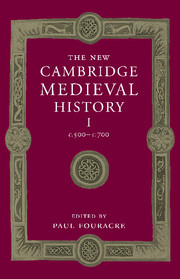Book contents
- Frontmatter
- Introduction: the history of Europe 500–700
- 1 The later Roman Empire
- 2 The Barbarian invasions
- 3 The sources and their interpretation
- PART I THE SIXTH CENTURY
- PART II THE SEVENTH CENTURY
- PART III THEMES AND PROBLEMS
- List of Primary sources
- Bibliography of secondary works arranged by chapter
- Index
- Frontispiece"
- Plate section"
- Map 3 Gaul/Francia in the sixth and seventh centuries"
- References
3 - The sources and their interpretation
Published online by Cambridge University Press: 28 March 2008
- Frontmatter
- Introduction: the history of Europe 500–700
- 1 The later Roman Empire
- 2 The Barbarian invasions
- 3 The sources and their interpretation
- PART I THE SIXTH CENTURY
- PART II THE SEVENTH CENTURY
- PART III THEMES AND PROBLEMS
- List of Primary sources
- Bibliography of secondary works arranged by chapter
- Index
- Frontispiece"
- Plate section"
- Map 3 Gaul/Francia in the sixth and seventh centuries"
- References
Summary
The past, as is often said, is made in the present. Today’s early Middle Ages are very different from the early Middle Ages of 1911, when the first volume of the first edition of the Cambridge Medieval History was published. That difference in appearance stems largely from a difference in the lenses through which the early medieval period is viewed. There are two aspects to these lenses; first, there are the sources of evidence available; and second there are historians’ ways of seeing the past. Since the first edition of the Cambridge Medieval History both have altered radically. Historical approaches to the written sources have changed in many ways and at several analytical levels. The written record, furthermore, is no longer seen as the only, and in some instances not even as the most eloquent, evidence left of the early medieval past. New evidence – new lenses – have become available. In addition to providing the newcomer to the period with a brief overview of the types of western European sources upon which the other contributions to this volume are based (with some reference to evidential forms further east), this chapter will therefore also present a short survey of the ways in which those forms of evidence are approached and the sorts of questions which they can, and cannot, answer.
Keywords
- Type
- Chapter
- Information
- The New Cambridge Medieval History , pp. 56 - 90Publisher: Cambridge University PressPrint publication year: 2005
References
- 7
- Cited by



